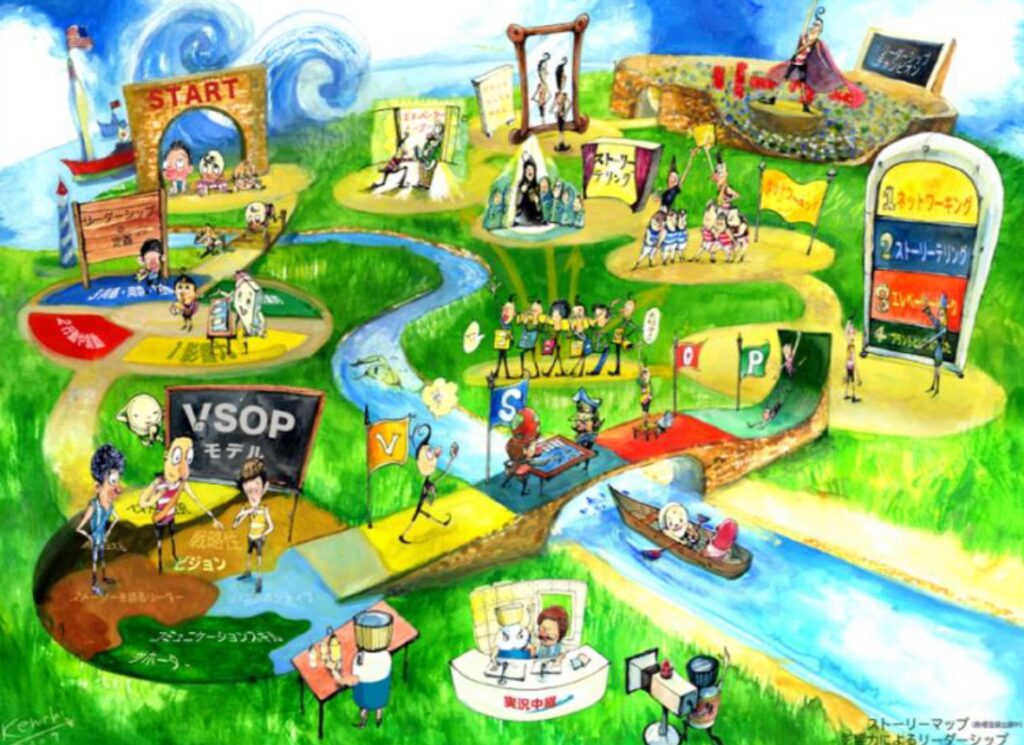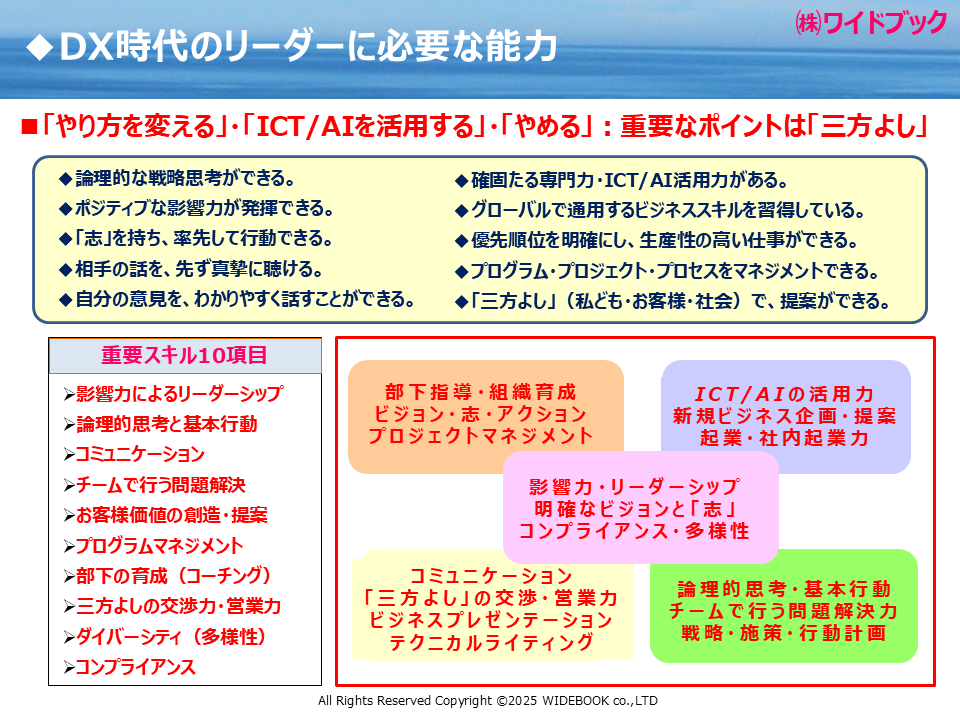
~The Power of Positive Influence~
This section is currently under construction. For inquiries, please contact us directly.
(このセクションは現在構築中です。お問い合わせは直接ご連絡ください)
This course is designed as an educational program intended for leadership development training in companies and organizations, as well as for a series of 15 consecutive sessions at universities and other higher education institutions.
Select Japanese for Learning(日本語に戻る)
Course Objectives:
- Understand the concept of positive influence and how to apply it effectively.
- Learn the key principles for leading a team to success.
- Acquire methods to enhance one’s own leadership skills.
- Deepen understanding of the “Cross Model of Leadership.”
- Recognize the importance of talent development alongside team success.
- Understand the core elements of “teaching” and “coaching” in human resource development.
- Be able to formulate a personal action plan for leadership improvement.
Table of Contents
Session 1 – What Is Leadership?
Session 2 – Why Is Leadership Necessary?
Session 3 – The Difference Between a Leader and Leadership
Session 4 – What Is a Team? Team Building
Session 5 – Diverse Forms of Leadership
Session 6 – Key Characteristics of Leadership
Session 7 – Evolving Leadership in a Changing World
Session 8 – Practical Leadership: The VSOP Model
① Visioning: Creating a Vision
Session 9 – Practical Leadership: The VSOP Model
② Strategy Setting: Formulating a Strategy
Session 10 – Practical Leadership: The VSOP Model
③ Objective Sharing: Aligning Goals
Session 11 – Practical Leadership: The VSOP Model
④ Passion to Win: Inspiring for Success
Session 12 – Leading and Developing Your Team Members (Part 1)
Session 13 – Leading and Developing Your Team Members (Part 2)
Session 14 – Leadership Capstone Workshop
Session 15 – Wrap-Up, Reflection, and Final Report Writing

Lesson 1
Main Contents:
1. Course Objectives
- Understand the importance of teamwork and leadership
- Learn how to demonstrate leadership through positive influence
2. Learning Goals (6 Key Points)
- Understand the significance of leadership through positive influence
- Express in writing how to further improve your leadership skills
- Assess situations and choose appropriate actions
- Take initiative and act with enthusiasm
- Learn how to energize team members and lead them toward success
- Actively participate in class sessions and group work
3. Course Features
- There are no single “right answers” or model responses
- It is important to think, try, and learn without fear of failure
- A final report will be submitted to assess your understanding
This course aims to help you develop the teamwork and leadership skills needed in society and in professional settings.
Introduction of Instructor Ayako Hiromoto
Hello, I’m Ayako Hiromoto, one of the instructors for this course.
You’ll also see Hisao Hiromoto, who shares the same last name, as a co-creator of the lecture videos.
To avoid confusion, please feel free to call me “Ayako-sensei” or “the female instructor.”
In my professional work, I support the development of younger generations at companies and universities.
I also serve as a director at WIDEBOOK Inc., where I’m involved in corporate training, consulting, and the production of e-learning materials.
One of my hobbies is cooking—especially preparing traditional Japanese New Year’s dishes, which I look forward to every year.
During the COVID-19 lockdowns, playing video games became a comforting way to relax.
I’m not very good at remembering names and faces, so I would really appreciate it if you took the initiative to speak to me!
In these web lectures, I speak in standard Japanese, but in face-to-face classes, about 80% of what I say comes out in the Osaka dialect—so please don’t be surprised!
Introduction of Instructor Hisao Hiromoto
Nice to meet you. I’m Hisao Hiromoto from WIDEBOOK Inc.
Today, I would like to briefly introduce my past activities and current initiatives.
In August 2007, I founded WIDEBOOK Inc. in Takatsuki City, Osaka Prefecture, focusing on human resource development and educational support.
In 2015, I launched WIDEBOOK Orange Field in Kainan City, Wakayama Prefecture, as an experimental project for regional revitalization.
Further expanding our initiatives, in 2020 we established WIDEBOOK Hiruzen Green Field in the Hiruzen Highlands of Okayama Prefecture, which now serves as a base for producing e-learning materials and disseminating information.
Regarding my personal background, I entered Osaka Prefecture University in 1980, where I conducted research focusing on water flow.
Later, my career expanded into education, computers, and internationalization, involving me in a wide range of educational environments from kindergarten to graduate school.
In 1987, I joined Fujitsu, where I spent nearly 20 years promoting the integration of business and ICT.
In 2002, I contributed to the launch of the Fujitsu Consulting Business Division, where I worked on building new business models leveraging ICT.
Today, at Hiruzen Green Field, I am creating development spaces that utilize natural environments such as tent sites.
I am also working on developing next-generation knowledge solutions, including video-based educational materials and certification systems.
Thank you very much for your attention.
Chapter 1: What is Leadership? 第1章 リーダーシップとは
Hello everyone, and welcome.
Today marks the beginning of our course on “Leadership.”
In this first session, I will provide an overview of the course and introduce the essential concepts of leadership that you will be learning.
First, I want to emphasize one important idea:
Leadership is not something reserved for a special few.
It is not an extraordinary talent, but rather a skill that anyone can develop and express little by little in daily life.
This belief forms the foundation of how this course is structured.
Today, using page 2 of your textbook as a guide, we will explore the skills that are valued in today’s professional world.
No matter what industry or role you are in, leadership is a crucial skill.
Here, leadership should not be thought of simply as the ability to “lead people,” but rather as the ability to “positively influence those around you.”
In particular, this course will focus on six key aspects of leadership:
- Demonstrating leadership through proactive engagement
- Presenting a clear vision
- Clarifying the path to achieving that vision
- Gaining empathy and sharing goals with others
- Showing passion and perseverance toward realization
- Practicing leadership that anyone can exhibit
Each of these points will be discussed in detail starting from Session 8 onward.
Also today, as part of our course introduction, we will do a short individual exercise.
This activity is designed to help you start thinking about what “leadership” means to you personally.
In this course, we value not only acquiring knowledge but also translating it into your own behavior and mindset.
I encourage you to approach each session with a positive and open attitude.
(1) Definition of Leadership
In today’s class, we will focus on the definition and concept of leadership.
Let’s begin by looking at some general definitions of the term.
According to Kojien, a well-known Japanese dictionary, leadership is defined as “the qualities, abilities, competence, and command of a leader.”
This sounds a bit formal and rigid, doesn’t it?
In contrast, the GLOBIS MBA Management Textbook, a well-known business reference, defines leadership as “the ability to influence others while involving them in the pursuit of a shared vision.”
So, how do we define leadership in this course?
Here, we define leadership as “positive influence.”
More specifically, it means taking initiative to guide individuals, teams, or organizations by presenting a clear vision, clarifying the path toward that vision, and encouraging others to move forward together.
What’s especially important to understand is that leadership does not require a special title or position.
In reality, leadership appears in everyday actions — in our words, behaviors, and attitudes.
It’s a power that anyone can develop and demonstrate, little by little, with awareness and intention.
After this explanation, we’ll do a short exercise to help you feel how close and personal leadership can actually be.
You’ll work with a checklist of 10 everyday actions — based on situations like student life, group work, or introducing yourself to others.
Examples include:
- Greeting others proactively
- Offering support to someone
- Looking at the bigger picture and taking initiative
Through this activity, I hope you’ll come to realize that leadership is not something distant or exclusive —
but rather a familiar skill that anyone can practice.
(2) Exercise: Thinking About Self-Introduction
In today’s class, we will discuss “patterns and structure of self-introductions.”
I’m sure most of you have had opportunities to introduce yourselves before.
But in fact, there are several patterns of self-introduction, and choosing the right one depending on the situation and purpose is very important.
For example, the way you introduce yourself during a job interview, at the beginning of a class, or when meeting someone for the first time — each requires different expressions and selected information.
Today, I’d like to use my own self-introduction as an example.
Please open your textbook to page 7.
We’ll look at how my introduction is structured and organized.
A clear self-introduction can be built around four key elements:
- Affiliation and Role – Where you belong and what you do
- Work Description – What your main tasks or responsibilities are
- Interests and Hobbies – What shows your personality and values
- Request for Support – What you’d like others to do to help you be yourself and show your leadership
This fourth point — “Request for Support” — is especially important, as it directly connects to the leadership skills we will explore in this course.
Clearly expressing what kind of support or interaction you would appreciate from others is a great first step toward building better relationships.
Now, I’d like you to try writing your own self-introduction using this structure.
Feel free to include hobbies or personal interests — they don’t need to be related to the course.
In fact, it’s better if your introduction reflects your unique personality.
You’ll have 10 minutes for this activity.
Afterward, I’ll ask a few of you to share your introductions with the class, so please take some time to prepare.
Conclusion
In today’s class, we explored the essence of leadership and how it can be practiced in real life.
First, we emphasized that the type of leadership we are discussing in this course is not a special ability possessed only by a select few.
Instead, it is a universal power — something that anyone can demonstrate.
We define it as positive influence.
So, what exactly is “positive influence”?
It means proactively engaging with your team members and those around you, presenting a vision, and moving forward together toward that goal.
It’s not about giving orders — it’s about inspiring empathy and collaboration.
Leadership is expressed through words, actions, and attitude.
For example, a simple comment, an act of consideration, or the way you face a situation — all of these reflect how you show up in your daily life.
In the second half of today’s class, we also covered how your performance in this course will be evaluated, along with the assignment on your growth goals.
Using pages 3 and 9 of the textbook, you worked on questions related to the definition of leadership.
This was not just an exercise in finding the “right answers,” but a chance for you to reflect and organize your own thoughts.
At the end of the session, you were asked to write about your personal growth goals — specifically, what kind of leadership you aim to practice and why.
The purpose of this task is to help you express your leadership intentions clearly in your own words.
As a reference, we also reviewed the summary on page 10 of the textbook.
Please use it to help draft and organize your ideas.
In the next class, we’ll take a deeper step into the practical application of leadership.
Thank you for your active participation today.
▶︎ Please complete and submit the Assignment for Session 1 using the designated form.

WIDEBOOK Inc.
1st Floor, Hiromoto Building
4-1 Tenno-cho, Takatsuki City, Osaka 569-0088, Japan
President and CEO: Hisao Hiromoto
Phone: +81-72-691-6667
Mobile: +81-80-5036-1468
Email: say@widebook.net
Website: https://www.widebook.net/
